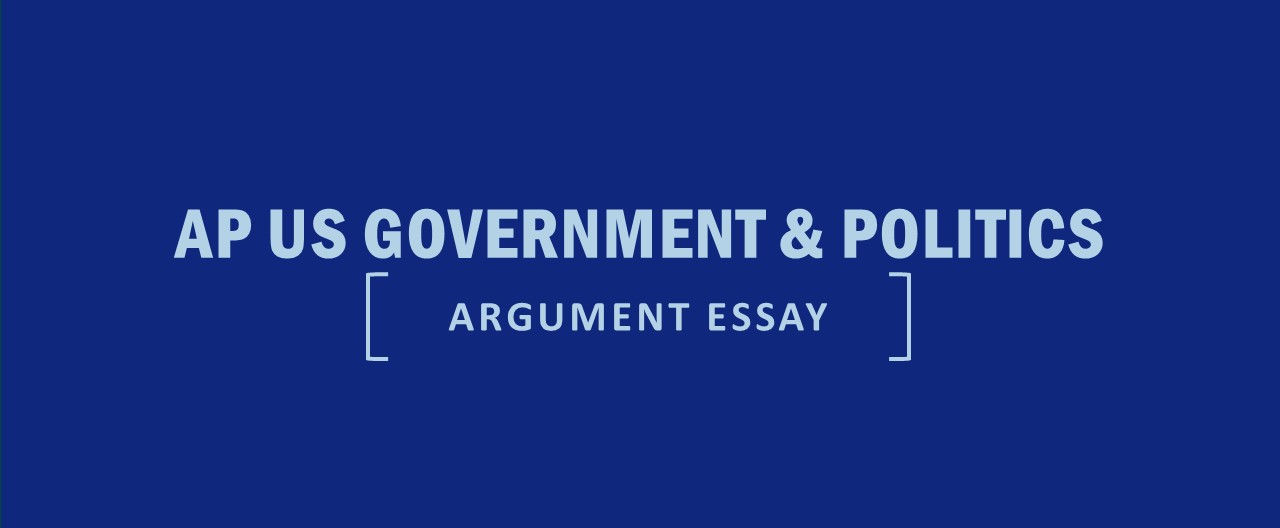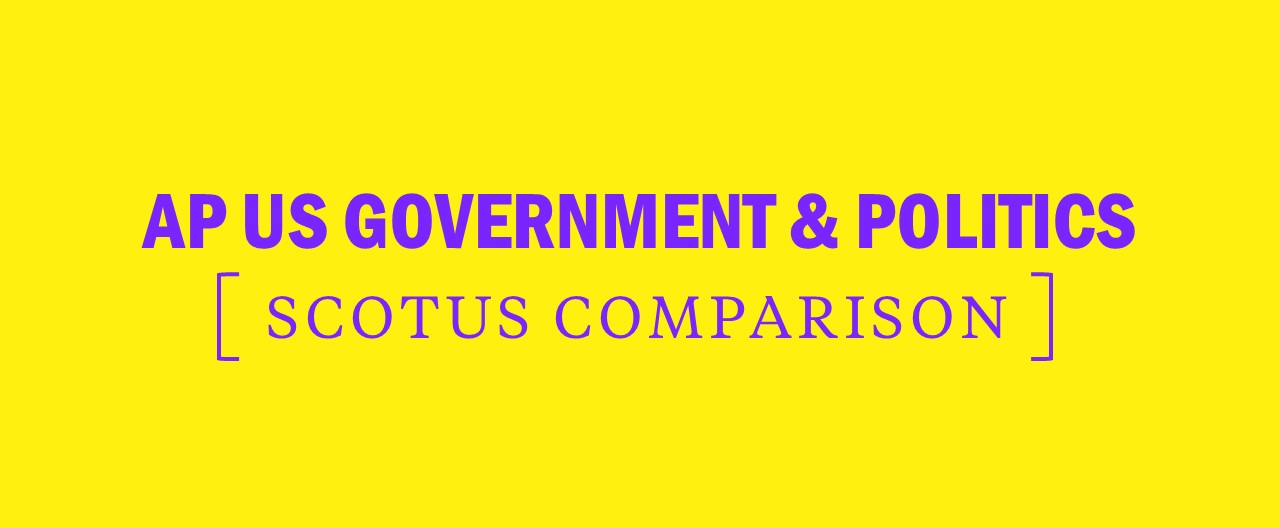AP U.S. Government and Politics: Argument Essay
Question 4 of the AP U.S. Government and Politics free response section will always be the Argument Essay. These questions begin with a brief paragraph about a given topic, such as the balance between federal and state powers. The prompt will then give specific instructions about how you must format your essay, including a list of several required foundational documents that are relevant to the topic at hand. You will need to discuss one of the listed documents as well as another piece of specific evidence from your own knowledge.
Argument Essay Strategies
The Argument Essay differs substantially from the other free-response questions on the AP U.S. Government and Politics exam, but you can and should still follow the Kaplan Method (AP-AP). It is recommended that you take 40 minutes to plan and write your Argument Essay (as opposed to 20 minutes each for the other free-response questions), so just double the time it typically takes you to complete each step of the Method.
While the scoring for the first three free-response questions is more straightforward—you earn points (or not) based on fully addressing each part of the prompt—the scoring for the Argument Essay is a little more complex. The following rubric outlines what the AP readers are generally looking for when they grade your Argument Essay; note the various categories and the ways you can earn points.

Sample Question
Step 1: Analyze the Prompt
Step 2: Plan Your Response
You’ll want to create a brief outline before you start writing, just like you would for any other full-length essay. As you saw from the rubric, AP readers are interested in your thesis development, your use of evidence, and your treatment of an alternative view. Everything you write should be toward one or more of those ends.
You will need to state a thesis that specifically addresses the prompt and makes a claim. Avoid rewording the prompt or being too general. A good question to ask yourself is, “Am I actually taking a position on this issue that someone else might argue against?” Also, while the Argument Essay necessitates a longer, more detailed response than the other free-response question types, it does not require a formal introduction; in fact, writing a lengthy introduction can take up valuable time and frustrate the AP reader who is scoring your essay. Assert your thesis as soon as possible, and then move into the rest of your response.
It is important to note that the Argument Essay’s topic and prompt wording will always intentionally allow for multiple positions. Therefore, you should be strategic and choose the position that you can best back up with evidence. You may even advocate for a different position than the one you personally agree with! To that end, no matter how strongly you feel about a topic, always present your evidence and claims in a balanced manner. Throughout your essay, even and especially when responding to an alternative viewpoint, avoid wording that makes it seem like your argument is simply your personal opinion (e.g., “I think” or “I believe,” or any language that is overly emotional).
With all of this in mind, a high-scoring writer might write the following outline:
Thesis: Trustee is the best model (ideals of Constitution)
Evidence:
- From list: Federalist 10
- Madison’s fear: large country + big gov’t = factions (many groups disagree)
- Trustee can mediate, come to concl, act in best interests
- From my own study: social mov’ts
- Needed trustee model to make change
- Civil rights and women’s rights movements
- The Civil Rights Act of 1964 and Voting Rights Act of 1965
Response to alternative view: Anti-Feds would fear large repub (Brutus), but pol system in place would keep trustee honest
Step 3: Action! Write Response & Step 4: Proofread
Sample High-Scoring Response
The trustee model of legislative representation is the best reflection of the founders’ intentions in setting up American democracy because it offers the best hope for what the Preamble to the Constitution calls “a more perfect union,” one that will bring together war- ring factions and increase harmony.
As James Madison pointed out in Federalist 10, it is inevitable that a republic will contain many groups which vehemently disagree. The bigger a country grows, the more frequent and violent factional clashes are likely to become. Madison was looking ahead to the U.S. that would burst the bounds of the original colonies and create more factionalism. This vision of an expanding, clashing nation makes the trustee model very appealing. A trustee Congressperson is one who will listen to all sides, make an independent judgment, but then go on to explain it so that opponents may be persuaded to change their minds, thus bringing resolution to conflicts.
A trustee is a representative willing to do the principled thing even if the public thinks otherwise. Many issues in our history have seemed so polarized that they were beyond resolution and could not wait for popular consensus. This was the case with civil rights issues and legislation in the 1960s. Technically, African Americans had the right to vote since the passage of the Fifteenth Amendment in 1870. However, this right was violently suppressed through intimidation tactics and a variety of restrictive measures such as poll taxes and literacy tests. It was not until the passage of the Voting Rights Act of 1965 that substantial voting protections were extended to all black people. The Voting Rights Act outlawed literacy tests and other tactics; under this act, federal officials were sent to the South to ensure that African Americans were allowed to vote free from fear and intimidation, and the election practices of local governments were held under greater scrutiny. Civil rights movement leaders had challenged discriminatory practices for decades, but due to intense polarization in society, there was no public consensus on how to address racism in voting practices or even agreement as to whether to address it at all. Legislators had to go against the opinions of the majority in order to act in a way that advanced American ideals for all citizens, and the public eventually caught up.
Similarly, legislators pushed through the Civil Rights Act of 1964 which was supported by people within social movements but not by the general populace. Additionally, the Civil Rights Act of 1964 touched on the goals of not just the civil rights movement but also the women’s rights movement; for example, Title VII of the Civil Rights Act prohibited sex discrimination in public accommodations. Members of these movements had been working for years to get society at large to expand rights and protections to all people. However, if legislators had waited to act until a majority of their constituency approved of these civil rights bills, the bills may never have passed. In this way, the trustee model can be used to uphold the rights of the minority despite majority resistance.
The trustee idea would have been opposed by Brutus and other Anti-Federalists. Brutus 1 warns that a large republic would necessarily be disconnected from its people. Following this logic, a concern with the trustee model would be that the representative would deviate too far from the will of the people and become despotic. But it is important to note that the people have the ultimate voice if they disagree with the trustee’s judgments: the power of the ballot. The legislator’s desire to stay in power is a strong check on him or her, acting as an incentive to listen to constituents.
All in all, the trustee is in the best position to reduce the intense factionalism Madison feared. Even before the advance of mass media, the trustee had many means to learn of the people’s different views and to explain why the legislator was voting a certain way, or advancing this or that philosophy. This give and take of ideas surely helped to get the republic through its rocky early decades, and also helped the country to recover from the volatile growing pains and changes in the mid-twentieth century by finding ways to bring people together and advance equal rights for all.
Sample Response Explanation and Scoring
- Thesis (0–1 pt): The writer sets up a clear X because Y sentence to introduce the thesis, which could be paraphrased as, The trustee model brings about harmony. Everything that follows is connected to the founders’ ideal of harmony. The writer would therefore earn 1 point for Thesis.
- Support (0–3 pts): There is more than enough evidence to gain the full 3 points for Support, as the writer explains Madison’s argument in Federalist 10 and elaborates upon relevant historical examples of disharmony that those acting as trustees helped to fix through assertive actions. In addition, the references to the Constitution and Brutus 1 (while unnecessary for earning full credit in Support) show a strong command of course material.
- Reasoning (0–1 pt): The writer earns the 1 point for Reasoning by clearly explaining how a trustee offers the best hope for Madison’s vision. Specifically, the writer asserts in paragraphs 3 and 4 how trustees could not wait for public opinion in order to act.
- Reply to Alternative Viewpoint (0–1 pt): There is a whole paragraph at the end dedicated to rebutting the Anti-Federalists’ objections. In this way, the writer makes it clear that this requirement has been met and earns the final 1 point.
Question-Specific Rubric: 6 points (1 + 3 + 1 + 1)




